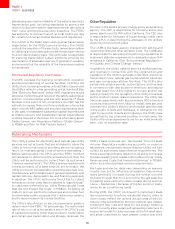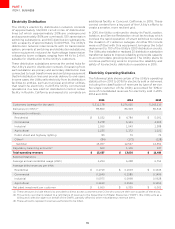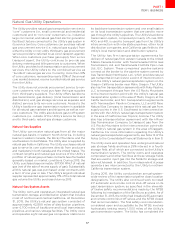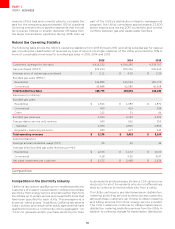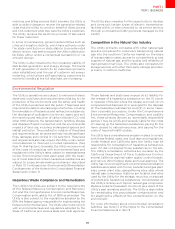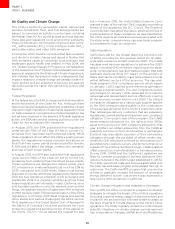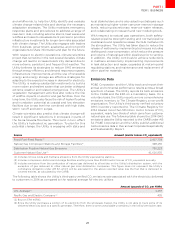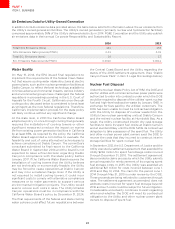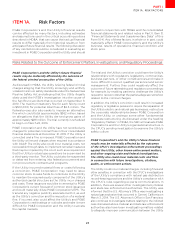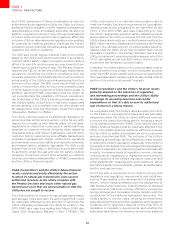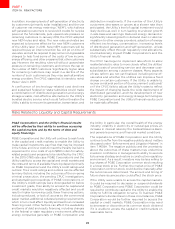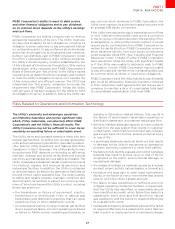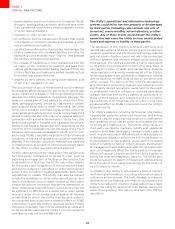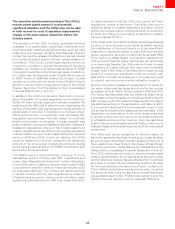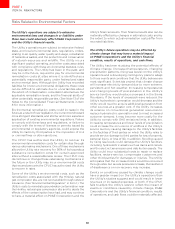PG&E 2015 Annual Report Download - page 28
Download and view the complete annual report
Please find page 28 of the 2015 PG&E annual report below. You can navigate through the pages in the report by either clicking on the pages listed below, or by using the keyword search tool below to find specific information within the annual report.
20
PART I
ITEM1.BUSINESS
Air Quality and Climate Change
The Utility’s electricity generation plants, natural gas
pipeline operations, fleet, and fuel storage tanks are
subject to numerous air pollution control laws, including
the federal Clean Air Act, as well as state and local statutes.
These laws and regulations cover, among other pollutants,
those contributing to the formation of ground-level ozone,
CO2, sulfur dioxide (SO2), mono-nitrogen oxide (NOx),
particulate matter, and other GHG emissions.
In December 2009, the EPA concluded that GHG emissions
contribute to climate change and issued a finding that
GHG emissions cause or contribute to air pollution that
endangers public health and welfare. In May 2014, the
U.S. Global Change Research Program (a confederation
of the research arms of thirteen federal departments and
agencies) released its third National Climate Assessment,
which stated that the global climate is changing and that
impacts related to climate change are already evident in
many sectors and are expected to become increasingly
disruptive across the nation throughout this century and
beyond.
Federal Regulation
At the federal level, the EPA is charged with implementation
and enforcement of the Clean Air Act. Although there
have been several legislative attempts to address climate
change through imposition of nationwide regulatory limits
on GHG emissions, comprehensive federal legislation has
not yet been enacted. In the absence of federal legislative
action, the EPA has used its existing authority under the
Clean Air Act to address GHG emissions.
In August 2015, the EPA published final regulations
under section 111(b) of the Clean Air Act to control CO2
emissions from new fossil fuel-fired power plants. While
these regulations do not aect the Utility’s existing power
plants, the regulations impose emission limitations on
fossil fuel-fired power plants constructed after January
8, 2014 and will aect the design, construction, operation
and cost of such power plants.
In August 2015, the EPA also published final regulations
under section 111(d) of the Clean Air Act to control CO2
emissions from existing fossil fuel-fired power plants.
These regulations are designed to reduce power plant
CO
2
emissions on a national basis by as much as 32% by
2030, compared with 2005 levels. States must submit
final plans to comply with these regulations by September
2016, but may request an extension to file such plans until
September 2018. It is uncertain whether and how these
federal regulations will ultimately impact California, since
existing state regulation currently requires, among other
things, the gradual reduction of state-wide GHG emissions
to 1990 levels by 2020. Following publication of the EPA’s
regulations, in October 2015 West Virginia and several
other states and parties challenged the EPA’s section
111(d) regulations in the United States Court of Appeals for
the District of Columbia Circuit and petitioned the Court
to stay the regulations pending review of the appeal on
the merits. The D.C. Circuit denied the request for stay
but in February 2016, the United States Supreme Court
granted a stay of the section 111(d) regulations pending
review of the appeal by the D.C. Circuit. The Supreme
Court’s decision may aect the nature, extent and timing of
implementation of these regulations. As described below,
the Utility expects all costs and revenues associated with
the state-wide, comprehensive cap-and-trade program
to be passed through to customers.
State Regulation
California’s AB 32, the Global Warming Solutions Act
of 2006, provides for the gradual reduction of state-
wide GHG emissions to 1990 levels by 2020. The CARB
has approved various regulations to achieve the 2020
target, including GHG emissions reporting and a state-
wide, comprehensive cap-and-trade program that sets
gradually declining limits (or “caps”) on the amount of
GHGs that may be emitted by major GHG emission sources
within dierent sectors of the economy. The cap-and-
trade program’s first compliance period, which began
on January 1, 2013, applied to the electricity generation
and large industrial sectors. The next compliance period,
which began on January 1, 2015, expanded to include the
natural gas and transportation sectors, eectively covering
all the economy’s major sectors until 2020. The Utility’s
compliance obligation as a natural gas supplier applies
to the GHG emissions attributable to the combustion
of natural gas delivered to the Utility’s customers other
than natural gas delivery customers that are separately
regulated as covered entities and have their own compliance
obligation. During each year of the program, the CARB
issues emission allowances (i.e., the rights to emit GHGs)
equal to the amount of GHG emissions allowed for that
year. Emitters can obtain allowances from the CARB at
quarterly auctions or from third parties or exchanges.
Emitters may also satisfy a portion of their compliance
obligation through the purchase of oset credits; e.g.,
credits for GHG reductions achieved by third parties (such
as landowners, livestock owners, and farmers) that occur
outside of the emitters’ facilities through CARB-qualified
oset projects such as reforestation or biomass projects.
During 2016, CARB and the California Legislature are
likely to consider proposals to achieve additional GHG
reductions beyond the 2020 target established in AB 32.
The Utility expects all costs and revenues associated with
the GHG cap-and-trade program to be passed through to
customers. The California RPS program that requires the
utilities to gradually increase the amount of renewable
energy delivered to their customers is also expected to
help reduce GHG emissions in California.
Climate Change Mitigation and Adaptation Strategies
During 2015, the Utility continued its programs to develop
strategies to mitigate the impact of the Utility’s operations
(including customer energy usage) on the environment and
to plan for the actions that it will need to take to adapt to
the likely impacts of climate change on the Utility’s future
operations. The Utility regularly reviews the most relevant
scientific literature on climate change such as sea level
rise, temperature changes, rainfall and runo patterns,


